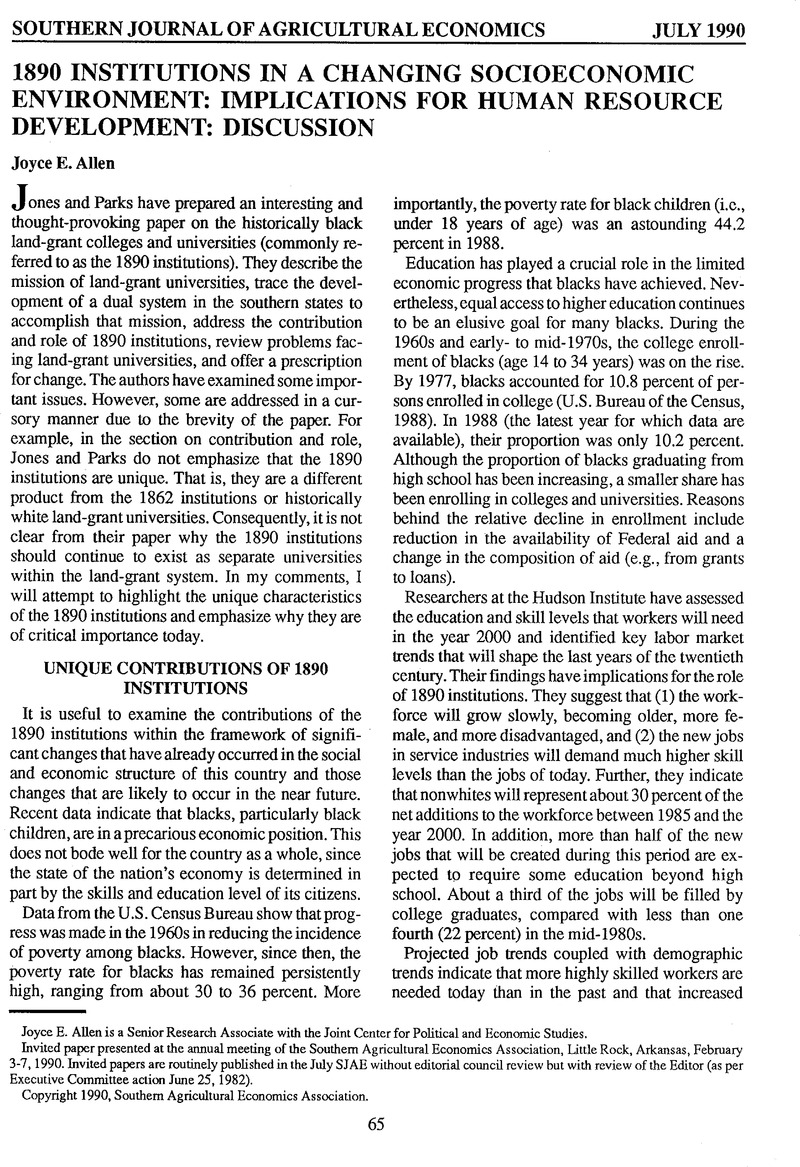No CrossRef data available.
Article contents
1890 Institutions in a Changing Socioeconomic Environment: Implications for Human Resource Development: Discussion
Published online by Cambridge University Press: 09 September 2016
Abstract
An abstract is not available for this content so a preview has been provided. Please use the Get access link above for information on how to access this content.

- Type
- Invited Papers and Discussions
- Information
- Copyright
- Copyright © Southern Agricultural Economics Association 1990
References
AAEA Committee on the Opportunities and Status of Blacks in Agricultural Economics. Directory of Black Agricultural Economists. December, 1989.Google Scholar
Allen, W.
Gender and Campus Race Differences in Black Student Academic Performances: Racial Attitudes and College Satisfaction. Atlanta, GA: Southern Education Foundation, 1986.Google Scholar
Brazziel, W.F. “Baccalaureate College of Origin of Black Doctorate Recipients.” The Journal of Negro Education, 52(1983): 102–109.Google Scholar
Connor, L.J.“Land-Grant Undergraduate Ag Programs: They Need Revitalizing.” Choices, 1(1989): 12–15.Google Scholar
De Vita, C J., and O'Hare, W.P.. America in the 21st Century: Human Resource Development. Population Reference Bureau. Washington, DC, 1990.Google Scholar
Fleming, , Jacqueline, . Blacks in College. San Francisco, CA: Jossey-Bass Publishers, 1984.Google Scholar
Garibaldi, A.(ed.). Black Colleges and Universities: Challenges for the Future. New York: Praeger Publishers, 1984.Google Scholar
Hudson Institute. Workforce 2000: Work and Workers for the Twenty-First Century. Indianapolis, IN: 1987.Google Scholar
Jones, , Dewitt, , and Parks, Alfred L.. “1890 Institutions in a Changing Socioeconomic Environment: Implications for Human Resource Development.” Paper presented at the Annual Meeting of the Southern Association of Agricultural Economics, Little Rock, Arkansas, February, 1990.Google Scholar
Mayberry, B.D.(ed.) Development of Research at Historically Black Land-Grant Institutions. Association of Research Coordinators, 1979.Google Scholar
McDowell, D.R. and Evans, S.H.. “Agricultural Economics Programs at 1890 Institutions: Current Status and Future Directions.” So. J. Agr. Econ., 22(1990):(in press).Google Scholar
National Advisory Committee on Black Higher Education and Black Colleges and Universities. Black Colleges and Universities: An Essential Component of a Diverse System of Higher Education. Department of Health, Education, and Welfare. Washington, DC: 1979.Google Scholar
Progress and Productivity Through Research and Service: Agricultural Research at the 1890 Institutions. The Association of Research Directors and The Cooperative State Research Service, U.S. Department of Agriculture, June, 1986.Google Scholar
Schuh, G.E.“Revitalizing Land Grant Universities: It's Time to Regain Relevance.” Choices, 2(1986):6–10.Google Scholar
U.S. Bureau of the Census. Money Income and Poverty Status in the United States: 1988 (Advance Data from the March 1989 Current Population Survey). Current Population Reports, Series P-60, No. 166. Washington, DC: U.S. Government Printing Office, 1989.Google Scholar
U.S. Bureau of the Census. School Enrollment - Social and Economic Characteristics of Students: October 1985 and 1984. Current Population Reports, Series P-20, No. 426. Washington, DC: U.S. Government Printing Office, 1988.Google Scholar




